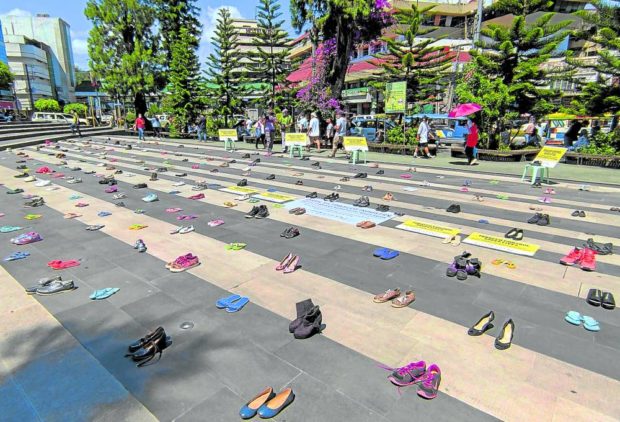321 pairs of shoes line Baguio park to mark daily smoking deaths

KILLER HABIT Pairs of shoes and other footwear take over Malcolm Square at downtown Baguio City on April 21 to symbolize 321 Filipinos who die each day from tobacco-related diseases. The art installation is put together by medical students and anti-tobacco advocates in the city. —NEIL CLARK ONGCHANGCO
BAGUIO CITY, Benguet, Philippines — Pairs of shoes, sandals, and slippers occupied Malcolm Square in downtown Baguio on Thursday to symbolize the 321 Filipinos who statistically die each day from tobacco smoke.
The art installation serves as a homage to the smoke-free programs of the summer capital, which anti-smoking crusaders hope would inspire other local governments about the need for stronger tobacco regulations, said Imagine Law executive director Sophia San Luis.
The Baguio government prohibited all forms of tobacco consumption in public spaces since the enactment of its smoke-free ordinance in 2017.
San Luis said the 321 daily fatalities from diseases associated with tobacco based on Department of Health data, meant 117,000 people perished annually unless local governments enacted and enforced stronger controls over the sale and distribution of cigarettes and new products being promoted by tobacco companies like vaping.
Nonsmoking generation
She said tobacco companies promised in the 1950s to stop selling cigarettes should scientists prove beyond any doubt that tobacco kills. “But 50 years hence it is still selling cigarettes and creating addicts out of our children.”
Article continues after this advertisementHowever, smoking is apparently not attractive to a new generation of young Baguio residents, based on a drop in tobacco users from 34 percent in 2016 to 17 percent in 2019.
Article continues after this advertisementThe downward trajectory of Baguio smokers was measured through surveys conducted every two years by the city health services office, involving teens aged 15 to 17 and the general adult population, said Dr. Donabel Tubera Panes, the city epidemiologist and a vocal tobacco critic.
Panes said a new survey might be conducted next year as the one scheduled in 2021 did not proceed because of the quarantines imposed in the last two years of the COVID-19 pandemic.
But the Baguio medical community is mulling a study on the behavior, lifestyle, and decision-making process of today’s nonsmoking youths, who have fended off peer pressure, heavy tobacco marketing that targets adolescents and, recently, the lure of vaping, she said.
The aggressive smoke-free campaign is currently dueling with the internet, which has become the prominent marketing platform for cigarettes, vaping, and future technologies that tobacco companies are developing, said Ralph Degollacion, program manager of Health Justice Philippines, who joined the art installation program.
“Tobacco companies tap online influencers to reach out to a younger market,” he said.
Revenue source
Reforms introduced in 2012 made cigarettes more expensive to discourage smokers, Degollacion said, yet it made tobacco a rich government revenue source.
Tobacco is grown in the provinces of the Ilocos, Cagayan and Central Luzon regions; the Visayan provinces of Capiz, Iloilo, Cebu, Negros Oriental and Leyte; and the Mindanao provinces of Zamboanga del Sur, Bukidnon, Misamis Oriental, North Cotabato and Maguindanao, according to the National Tobacco Administration website.
This year, the government had raised the excise taxes on tobacco and vaping materials, from P50 for every cigarette pack to P55 as of January. The Inquirer has reported the rise in “sin tax collections from cigarettes and alcoholic beverages to a total of P227.6 billion from P224.6 billion in 2019.”
Groomed for tobacco production by the Spanish colonial government since 1881, the Philippines has seen its tobacco yield increase despite reform programs aimed at introducing new cash crops to tobacco farmers, Degollacion said.
RELATED STORIES
In Baguio, kicking smoking habit is a community effort
Businesses, tobacco group challenge Baguio law banning sale of cigarettes by the stick